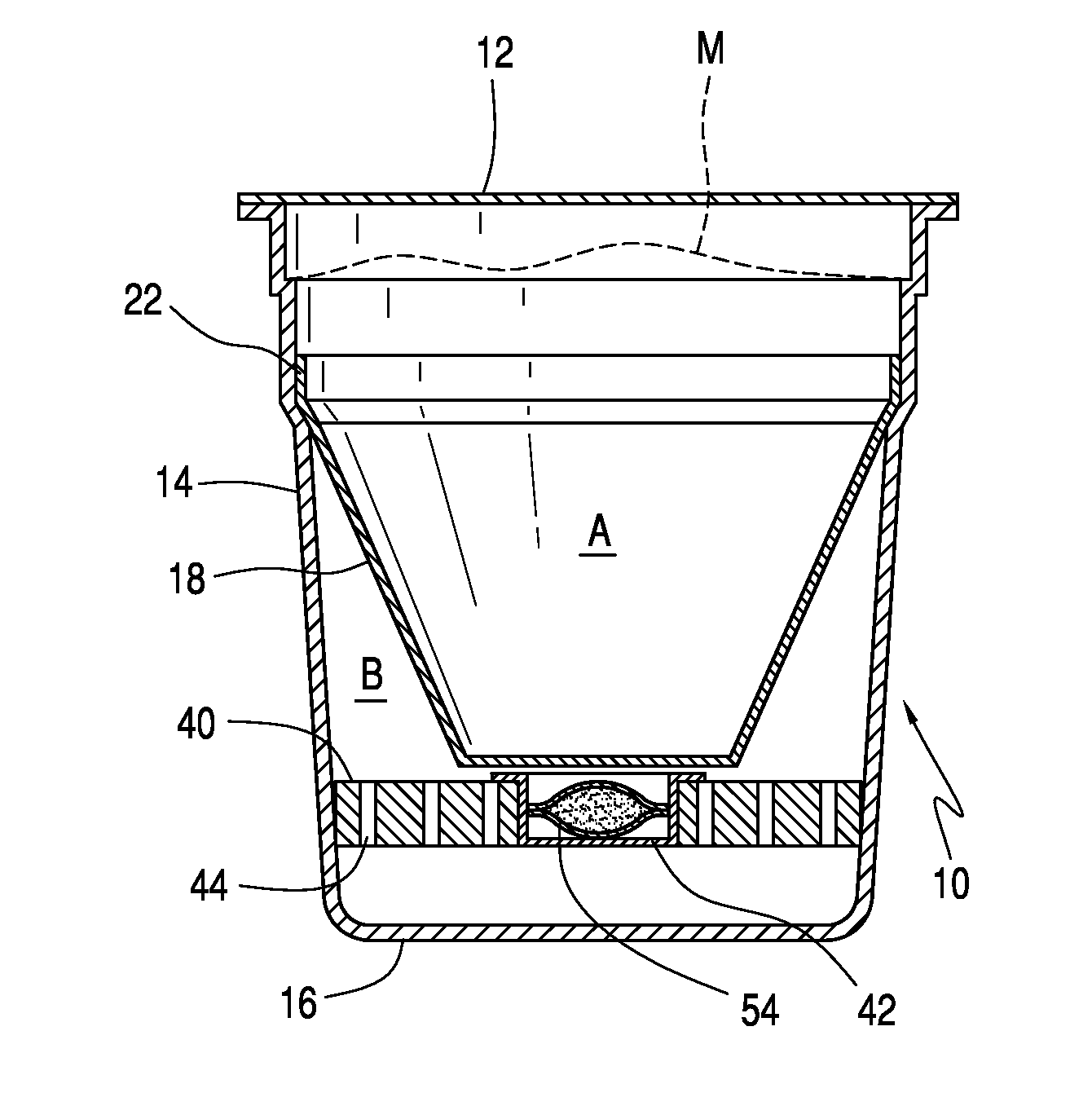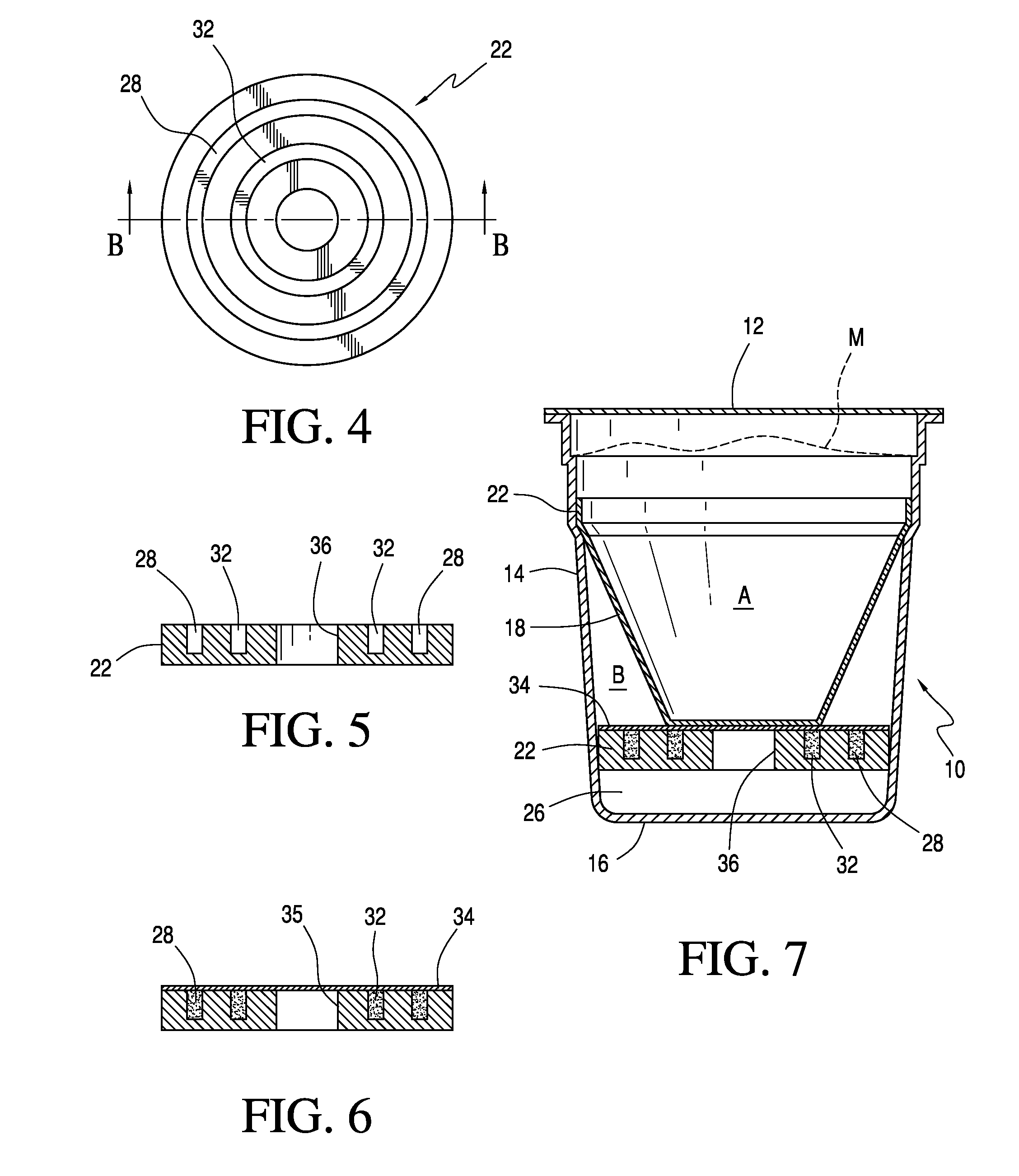Oxygen and carbon dioxide absorption in a single use container with an absorbent support below the filter
a technology of oxygen and carbon dioxide, which is applied in the field of absorption of oxygen and/or carbon dioxide, can solve the problems of food deterioration, many undesirable odors have become detectable, and the amount of desirable aroma has decreased noticeably
- Summary
- Abstract
- Description
- Claims
- Application Information
AI Technical Summary
Benefits of technology
Problems solved by technology
Method used
Image
Examples
example 1
Oxygen Scavenging Films Packaged with Coffee
[0066]An extruded film that contained oxygen scavenger formulations was prepared by following a method described in co-assigned U.S. patent application Ser. No. 12 / 416,685, filed Apr. 1, 2009, hereby incorporated by reference, to test the oxygen scavenging behavior with the presence of coffee. The film was extruded from a mixture of 17 / 3 / 80 weight ratio of iron, sodium chloride and low density polyethylene from a film extrusion process. The materials were pre-mixed in a container and fed into a twin screw extruder with the extruder and die temperatures set at 220° C. Films, approximately 9 mil thick, were extruded from a 6″ die and collected on a spool. The 9 mil film samples, cut in approximately 1″ square pieces, were moisturized by placing drops of water on the surface of the film and blotted to remove dripping water. The films were placed in 7″×7″ plastic barrier bags with a package of approximately 8.8 gm ground coffee sealed in Tyvek...
example 1a
Coffee without Oxygen Scavenger
[0067]As a control, a separate barrier bag that consists of approximately 8.8 gm ground coffee removed from a container, conditioned in ambient temperature and environment for more than one hour, was sealed in Tyvek breathable film bag without scavenger, and was tested for oxygen concentration change over the same time period.
[0068]Table 1 shows the results of oxygen concentration change with time for two different scavenger loadings. The oxygen scavenging rate increases with the net amount of the scavengers used. In 88 hrs, a sample with a starting O2 of 1.98% dropped to 0.04% with 0.52 gm of the scavenger in the film. A sample of 2.21% O2 dropped to 1.08% with 0.17 gm of the scavenger in the film. The O2 concentration of a sample with coffee packet only without scavenger dropped from 2.45% to 2.37% with some variation over the same time period. This example demonstrated that the scavenger gives much higher oxygen absorption rate than the combination ...
example 2
Oxygen Scavenging Film Laminated on Coffee Lidding
[0069]Oxygen scavenging film was extruded with a mixture of 5.1 / 0.9 / 94 weight ratio of iron / NaCl / PLA in which PLA was NatureWorks PLA 2002D resin. The iron is the same as in Example 1. The composition of poly (lactic acid) resin (PLA) was pre-dried in a desiccant oven at 60° C. for at least 4 hrs before extrusion. The mixture was extruded in a twin screw extruder to make 4″ wide and 4 mil thick films. A coffee lidding foil film peeled from a Green Mountain 55 cc cup coffee was used for lamination test. Dow Chemical Integral™ 801 adhesive film was used as an adhesive for lamination test. The extruded Fe / PLA film was stacked with the Integral film and the lidding film to form Fe / PLA-adhesive-lidding sandwich structure. The structure was heat pressed in a heat sealer to form an oxygen-scavenging lidding structure.
PUM
 Login to View More
Login to View More Abstract
Description
Claims
Application Information
 Login to View More
Login to View More - R&D
- Intellectual Property
- Life Sciences
- Materials
- Tech Scout
- Unparalleled Data Quality
- Higher Quality Content
- 60% Fewer Hallucinations
Browse by: Latest US Patents, China's latest patents, Technical Efficacy Thesaurus, Application Domain, Technology Topic, Popular Technical Reports.
© 2025 PatSnap. All rights reserved.Legal|Privacy policy|Modern Slavery Act Transparency Statement|Sitemap|About US| Contact US: help@patsnap.com



